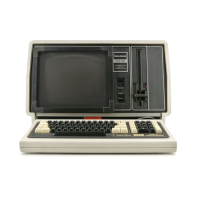The cursor is placed on the first character (a space)
to
be moved. Press the
SELECT
Function Key (Cfl)) on the top row of the keyboard. Move the cursor
to
the right
by pressing
8 until
it
is
over the carriage return character
at
the end
of
line 40.
As
the cursor moves, you will note that the characters are printed in reverse video (light
on dark). This indicates which characters are going
to
be moved. Line 40 should
appear
as
Press the CUT Function Key
(~).
When you
do
this, the characters marked will
disappear from the screen. Line 40 should now appear
as:
The characters to be moved
to
line 20
CT
=
CT
+ 1
which no longer appear on the display have been moved
to
a temporary storage area
in
the computer called the
"PASTE
buffer."
The operation
of
deleting characters,
as
done above,
is
called a
"cut."
The remaining characters
in
line 40, namely the number 40 and the carriage return,
will now be deleted. Position the cursor so that it is
to
the right of the carriage return
character.
£1121.
Press
(BKSPl
three times. This deletes what was left
of
line 40. Since
(BKSPl
was
used,
instead
of
using a
"SELECT"
and
"CUT"
operation, these characters are not saved
in
the "PASTE buffer."
Your program should appear
as:
1.
G1
I !'.IPUT
II
j\IU!'IBEr~
Ii;
N
20
IF
N = 0
THEN
GOTO
60
ELSE
3~1
,':;\.,1
~,
AI)
..;-
N~.
50
GOTO
10~
60
PRINT
"AVERAGE
IS";
AV/CT.
The only remaining operation
is
to insert the characters saved
in
the PASTE buffer
into line 20. Position the cursor in line 20 over the carriage return character. When
this
is
done, line 20 will appear
as
82

